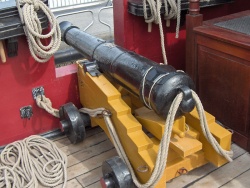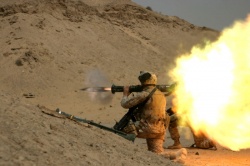Recoil
Recoil, in common everyday language, is considered the backward kick or force produced by a gun when it is fired. In more precise scientific terms, this force is equal to the time derivative of the backward momentum resulting when a gun is fired.
The backward momentum is equal to the mass of the gun times its reverse velocity. This backward momentum is equal to the sums of the two forward momentums by the law of conservation of momentum and is due to and equal to the projectile's mass times its velocity added to the mass of the escaping gases, burnt propellant, unburnt propellant, and other gases, times their respective velocities. Provided that enough information is known for how all the velocities vary versus time, it becomes theoretically possible to determine all the accelerations versus time, and hence to calculate the total recoil force versus time. The force associated with the recoil may thus be calculated by using the law of conservation of momentum, provided that enough information regarding changes in momentum versus time is known. In practice, however, it is often easier simply to measure the recoil force resulting for a given load, rather than to estimate all the variations occurring in momentum versus time.
In most small arms, the force of the recoil is absorbed usually by the body of the shooter; in heavier guns such as mounted machine guns or cannons, the recoil is absorbed by a mounting system.
Contents[hide] |
[edit] Recoil versus energy
Recoil is from the law of conservation of momentum. Energy is a quality of work that can be measured. When discussing recoil and energy it tends to be more understandable if one thinks of them separately, like a real life experience. Recoil generally conveys an action with an equal and opposite reaction as a topic for discussion. Energy and that energy specific to recoiling firearms conveys "kick" as in what a shooter feels.
In the firearms lexicon, the energy of a recoiling firearm is called felt recoil, free recoil, and recoil energy. This same energy from a projectile in motion is called: muzzle energy, bullet energy, remaining energy, down range energy, and impact energy.
In mathematics, the recoil and energy of a recoiling firearm are different as well. The recoil of a firearm, both large and small, is a function of the law conservation of momentum and can be stated mathematically as mf·vf = mp·vp from Newton's third law. The equation describes the recoil of a firearm and the user or gun-mount system in its entirety. The action of firing includes the powder charge mass and projectile at any position along the barrel. The equal sign (=) that represents the total thermodynamic energy held within the powder charge. "mf·vf" found on the left side of the equation represents the backwards motion of the firearm or firearm system. "mp·vp" found on the right of the equation represents the forward motion of the powder charge mass and projectile moving down the barrel, before either has left the barrel.
The energy of a recoiling firearm can be stated mathematically as Et=.5·m·v² from Newton's second law. This equation is known as the "classic statement" and yields a measurement of force in joules (foot-pound force in non-SI units). The calculated energy is the amount of work that can be done by the recoiling firearm, firearm system, or a projectile because of their motion. When looking at the classic statement (Et=.5·m·v²): the "Et" in energy represents the translational kinetic energy of a recoiling firearm, firearm system, or projectile’s motion after it exits the barrel. The "m" in the equation represents the mass of the firearm, firearm system, or projectile. The "v²" in the equation represents the square of the velocity for the firearm or firearm system in backwards motion and the projectile’s forward motion after it exits the barrel.
The difference between these two equations and events is that during recoil, m·v = m·v, a projectile has not left the barrel. When calculating the energy of a recoiling firearm, Et=.5·m·v², the projectile has exited the barrel. Again, recoil is a principle of the law of conservation of momentum and the energy of a recoiling firearm, firearm system, or projectile is a quality of work that can be measured.
It can also be helpful to think of the energy of a recoiling firearm or firearm system as a byproduct of work being done to accelerate a projectile towards its target.
See physics of firearms for a more detailed discussion.
[edit] Perception of recoil
For small arms, the way in which the shooter perceives the recoil, or kick, can have a significant impact on the shooter's experience and performance. For example, a gun that "kicks like a mule" is going to be approached with trepidation, and the shooter will anticipate the recoil and flinch in anticipation as the shot is released. This leads to the shooter jerking the trigger, rather than pulling it smoothly, and the jerking motion is almost certain to disturb the alignment of the gun and result in a miss.
This perception of recoil is related to the momentum associated with a particular gun. The total force of recoil is associated with the momentum of a gun, the momentum being the product of the mass of the gun times the reverse velocity of the gun. A heavier gun, that is a gun with more mass, will manifest the momentum by exhibiting a lessened acceleration, and, generally, result in a lessened perception of recoil.
One of the common ways of describing the felt recoil of a particular gun/cartridge combination is as "soft" or "sharp" recoiling; soft recoil is recoil spread over a longer period of time, that is at a lower acceleration, and sharp recoil is spread over a shorter period of time, that is with a higher acceleration. With the same gun and two loads with different bullet masses but the same recoil force, the load firing the heavier bullet will have the softer recoil, because the product of mass times acceleration must remain constant, and if mass goes up then acceleration must go down, to keep the product constant.
Keeping the above in mind, you can generally base the relative recoil of firearms by factoring in a number of figures such as bullet weight, powder charge, the weight of the actual firearm etc. The following are base examples calculated through the Handloads.com free online calculator, and bullet and firearm data from respective reloading manuals (of medium/common loads) and manufactur specs:
- In a Glock 22 frame, using the empty weight of 1.43 lb (0.65 kg), the following was obtained:
- 9 mm Luger - Recoil Impulse of .78 ms- Recoil Velocity of 17.55 ft/s (5.3 m/s) - Recoil Energy, 6.84 ft·lbf (9.3 J)
- .357 Sig - Recoil Impulse of 1.06 ms- Recoil Velocity of 23.78 ft/s (7.2 m/s) - Recoil Energy, 12.56 ft·lbf (17.0 J)
- .40 S&W - Recoil Impulse of .88 ms- Recoil Velocity of 19.73 ft/s (6.0 m/s) - Recoil Energy, 8.64 ft·lbf (11.7 J)
- In a Smith and Wesson .44 Magnum with 7.5-inch barrel, with an empty weight of 3.125 lb (1.417 kg), the following was obtained:
- .44 Remmington Magnum - Recoil Impulse of 1.91 ms- Recoil Velocity of 19.69 ft/s (6.0 m/s) - Recoil Energy of 18.81 ft·lbf (25.5 J)
- In a Smith and Wesson 460 7.5-inch barrel, with an empty weight of 3.5 lb (1.6 kg), the following was obtained:
- .460 S&W Magnum - Recoil Impulse of 3.14 ms- Recoil Velocity of 28.91 ft/s (8.8 m/s) - Recoil Energy of 45.43 ft·lbf (61.6 J)
- In a Smith and Wesson 500 4.5-inch barrel, with an empty weight of 3.5 lb (1.6 kg), the following was obtained:
- .500 S&W Magnum - Recoil Impulse of 3.76 ms- Recoil Velocity of 34.63 ft/s (10.6 m/s) - Recoil Energy of 65.17 ft·lbf (88.4 J)
[edit] Dealing with recoil in mounted guns
A recoil system absorbs momentum, for example, by the barrel moving backwards. Cannons and such weapons without a recoil system roll several meters backwards when fired.
In a soft-recoil system, a gun's barrel is moved forward prior to shooting. As the barrel is forced backwards by the recoil force, the energy is reduced by friction, resulting in less of an overall "kick". One of the early guns to use this was the French 65 mm mle.1906; however, this method did not receive much attention until the 1970s.
In a mounted gun, a down-recoil system is when the barrel is forced down on a spring mechanism, and immediately springs back up to its original position. This modern system, since around 2003, can work so rapidly that it works with machine guns.
Recoilless rifles (which are anything but) and rocket launchers exhaust gas to the rear, balancing the recoil. They are used often as light anti-tank weapons.
[edit] Misconceptions about recoil
Hollywood depictions of firearm victims being thrown through several feet backards are inaccurate; if this were the case, the shooter would also be thrown backwards with equal force (see Newton's third law). Gunshot victims frequently do collapse when shot, which is usually due to psychological motives, a direct hit to the central nervous system, and/or massive blood loss (see Stopping Power), and is not the result of the momentum of the bullet pushing them over.[1]
Of course this does not apply if the victim is hit by heavy weapons fire, such as aircraft cannon, where the momentum effects can be significant. The recoil from such a weapon is equally enormous, and requires it to be mounted on a weapons platform. An example of the latter would be the Handheld Minigun shown in the film Predator. For example, the gun shown in the movie is based on the prototype XM214 Microgun, a six barrel electric Gatling gun which fires the 5.56 × 45 mm NATO cartridge at a rate of 4000 to 6,000 rounds per minute. Each cartridge accelerates a 4 grams (62 gr) bullet to about 850 m/s (2,800 ft/s); at a moderate rate of fire of 4,000 rounds per minute, a one second burst will accelerate 267 grams (4,120 gr) of mass. Assuming a 100 kilograms (220 lb/16 st) user, and 30 kilograms (66 lb) for the XM214 and ammunition, that one second burst will result in the gun and user being accelerated to 1.7 m/s (5.6 ft/s).[2]
[edit] See also
[edit] External links
[edit] References
- ↑ ANTHONY J. PINIZZOTTO, Ph.D., HARRY A. KERN, M.Ed., and EDWARD F. DAVIS, M.S. (October 2004). "One-Shot Drops Surviving the Myth". FBI Law Enforcement Bulletin. Federal Bureau of Investigation.
- ↑ XM214 Microgun information
- Arthur B. Alphin, Any Shot You Want, The A-Square Handloading and Rifle Manual, On Target Press, 1996.
- Edward F. Obert, Thermodynamics, McGraw-Hill Book Co., 1948.
- Mc Graw-Hill encyclopedia of Science and Technology, volume ice-lev, 9th Edition, Mc Graw-Hill, 2002.

